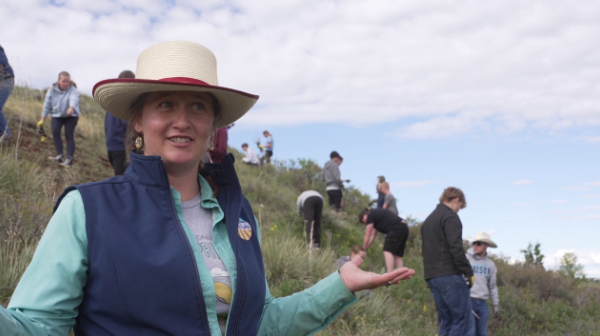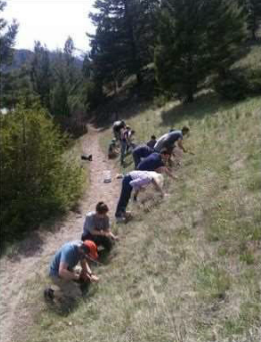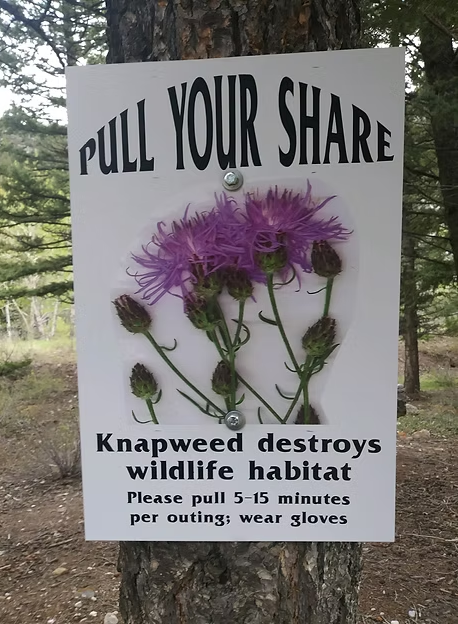News
High school students pull their share of noxious weeds

GREAT FALLS — On Wednesday, May 21, 2025, approximately 100 high school students spent some time at Giant Springs State Park to learn about invasive species, and pull their share of spotted knapweed.
Full StoryPulling together: Hundreds of Montana
high school students working to halt
knapweed
David Murray
Great Falls Tribune
View Comments
0:45
0:59

As spring's rains and warmer temperatures bring forth a new growth of grass to the Rocky Mountain Front, a more insidious plant is attempting to take over the landscape and push out the nutritious forbs and grasses that so much wildlife depends on.
Spotted knapweed has invaded large swaths of Montana's pastureland, open space and natural landscapes making them unsuitable for livestock and wildlife alike. Central Montana's high school students will soon be doing their part to fend off this noxious invader.
Near the end of May upward of 240 high school students from Great Falls and Simms will spend one of their final school days before the summer break pulling knapweed from trails and meadows west of Augusta and around Giant Springs State Park in Great Falls. The effort has been organized by Dan Wilkins, a retired high school teacher who spent 29 years teaching applied physics to students in the Great Falls School District.
This will be the fifth year Wilkins has taken students to the Rocky Mountain Front to pull noxious weeds. In that time the effort has expanded into a campaign called "Pull Your Share," which encourages all Montanans to take a few minutes while out recreating to eliminate as many weeds as possible.
"If everybody takes five to fifteen minutes out of their day to pull knapweed, which isn't asking a lot, the cumulative effect is going to be substantial," Wilkins said.
The proliferation of spotted knapweed is far worse than just a biological nuisance. Native to central Europe, the weed was first detected in British Columbia in 1883, likely arriving as a contaminant in imported alfalfa or in soil used as ship ballast. It has since spread throughout Canada and into almost every state in the United States, including every county in Montana.
Each adult knapweed plant can produce well over 1,000 seeds. Left unchecked it can overtake entire landscapes. In Montana alone, knapweed covers some 4.5 million acres and costs ag producers more than $40 million annually in herbicide and lost productivity. Furthermore, the plant engages in what amounts to chemical warfare to inhibit the growth of other competing plants.
"It puts a toxin in the soil called 'catechin' (pronounced CAT-e-kin), and no forage plants can grow in that toxic soil," Wilkins explained. "You end up with all these interlocking circles of catechin where forage can't grow. So you've got a plant that can spread extremely fast, it puts toxins in the soil, and it drives out the forage species that elk, deer, bighorn sheep - all these different wildlife species rely upon.
In some parts of Montana wildlife biologists have documented elk herds changing their historical migration routes to avoid widespread infestations of spotted knapweed.
One of the primary vectors for knapweed to spread is when its seeds are inadvertently picked up by hikers on their boots and clothing and carried further into the backcountry. Patches of spotted knapweed can now be found in the interior of the Bob Marshall Wilderness.

During three days toward the end of May, approximately 240 students from Great Falls and Simms high schools will board buses for the Sun River Canyon east of Augusta, and Giant Springs State Park. Once there they will spend the day pulling newly emerging knapweed plants, as well as houndstounge, another noxious weed proliferating in Montana.
The students will work with land management professionals from the U.S. Forest Service, Cascade County Weed Division and Jefferson County Weed District, learning about the harmful effects of noxious weeds on Montana's environment and how to reduce and eliminate noxious weed infestations. They will also install Pull Your Share signs to help recreationalists identify knapweed and encourage them to take a few minutes to pull it themselves, and will learn about career opportunities in land management fields.
Wilkins said that the goal of the high school program is greater than just eliminating a few acres of knapweed. He hopes to instill in students a lifelong ethos of community service, and a dedication to preserving our nation's public lands. To that end each class will be asked to adopt an outdoor recreation site and return to it periodically.
"The intent is that each class will adopt a section of trail, a trail head, a boat launch or campsite that has knapweed in it," said Wilkins, "and they will return year after year to pull knapweed at that site. Hopefully over the long haul they'll be able to reduce knapweed at those sites, resulting in less knapweed getting spread into the backcountry
Wilkins hopes the Pull Your Share program will eventually lead to a cultural shift, similar to what happened in the 1980s when "Leave no trace" and "Pack it in, Pack it out" became the common and accepted practice for hikers, fishermen, hunters and horsemen visiting public lands.
"We're hoping to spread it to other schools, and to effect more and more recreators," Wilkins said of the effort to eliminate knapweed. "And it appears to be working. We're seeing areas along the trails where people are pulling the weeds on their own, and we've even found bags of weeds near the signs. Through our efforts and the efforts of the Forest Service we already have sites that are substantially decreased in knapweed."
Since its inception the costs of the Pull Your Share program; money for signs, buses, porta potties, gloves and lunches for all the students have been covered by grants from local conservation districts, the Cascade County Weed Division and the Greenfields Irrigation District. This year, for the first time, Pull Your Share received a grant from the Montana Noxious Weed Trust Fund.
But as the effort to eliminate spotted knapweed from the landscape expands, so will its costs. Wilkins hopes more individuals, businesses and organizations will consider contributing to the cause.
Anyone interested in learning more about the Pull Your Share program is encouraged to contact Dan Wilkins at 406-750-4116, or by email at danwilkinspys@gmail.com.
David Murray is Natural Resources/Agriculture reporter for the Great Falls Tribune.
To contact him with comments or story ideas;
email dmurrav@greatfallstribune.com or call (406) 403-3257. To preserve quality, indepth
journalism in northcentral Montana subscribe to the Great Falls Tribune.
Future Farmers of America (FFA) Pull Your Share
Our featured weed pull this year is a Future Farmers of America (FFA) Pull Your Share weed pull at Mill Creek Campground east of Sheridan. This weed pull was started by Colton Hellwinkel in 2022. Colton is the FFA Advisor at Twin Bridges High School. Gloves and weed pry tools were provided by Liz Lodman, administrator with Montana Invasive Species Council (MISC). Students and advisors from the following FFA chapters participated in the educational weed pull: Twin Bridges, Stevenville, Gardiner, Frenchtown, Beaverhead, East Helena, Valier, Mission Valley, Fairfield, and Lima.
In addition to weed pulls established from their inception as Pull Your Share weed pulls, we also had several existing weed pulls add the Pull Your Share message through signage and education. For example at the Rock City Clean-up Day near Valier, approximately 25 attendees pulled noxious weeds. The Pull Your Share message of "pull 5 to 15 minutes per outing" was promoted. There were also 5 weed pulls in the Glacier Two Medicine area that incorporated Pull Your Share signs and promoted the Pull Your Share message.
Pull Your Share Signs
An additional 7 Pull Your Share signs were installed this year bringing our total to approximately 35 signs installed at various trailheads, campgrounds, and boat launches around the state. We are seeing evidence of recreators pulling their share of noxious weeds near the signs, especially along the River Edge Trail at Giant Springs State Park (Great Falls). Colin Threlkeld with the Madison Conservation District installed a Pull Your Share sign with Ennis Middle School science students during their weed pull at the Bear Creek Trailhead near Ennis, MT.
Filed School
Pull Your Share in coordination with the Madison Conservation District, the Jack Creek Preserve, the White Hall Noxious Weed Project, and the Kids in Action Program, created a multi-day outdoor noxious weed course for teachers that was hosted by the Jack Creek Preserve near Ennis, MT July 27-28, 2023. Shared below are photos and a summarization of the field school that was put together by Carla Hoopes with the Kids in Action Program. Thanks Carla!
Conference Presentations
Pull Your Share was invited to speak at several conferences. In October 2022, Colin Threlkeld with the Madison Conservation District provided a Pull Your Share presentation to our state's weed coordinators at their annual training in Havre, MT. In February 2023, a Pull Your Share PowerPoint presentation was given at the Montana Weed Control Association State Conference in Helena. Colin and I were asked by Stephanie Criswell, the Bureau Chief of all Montana Conservation Districts, to provide a Pull Your Share noxious weed presentation at the state Conservation Districts Conference in Billings, MT on November 16, 2023. The goal of the above presentations is to encourage all Conservation Districts and Weed Districts to start Pull Your Share educational weed pulls.

